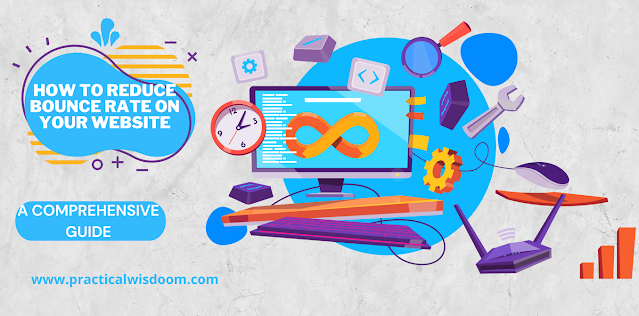As a website owner, one of your main goals is to keep visitors on your site for as long as possible. However, a high bounce rate can be discouraging, indicating that visitors are leaving your site almost immediately after arriving. A high bounce rate can negatively affect your website's search engine rankings and conversion rates. In this article, we will explore what bounce rate is, how to measure it, and what steps you can take to reduce it and keep visitors engaged.
What is Bounce Rate?
Bounce rate refers to the percentage of visitors who leave your website after visiting only one page without engaging in any activity, such as clicking on any links, filling out forms, or making purchases. A high bounce rate can indicate that visitors are not finding what they are looking for on your website, or they are not interested in your content.
How to Measure Bounce Rate
You can use Google Analytics to measure your website's bounce rate. To access your bounce rate data, log in to your Google Analytics account and navigate to the Audience Overview report. You will see the bounce rate percentage at the top of the page.
Why High Bounce Rate is Bad for Your Website
A high bounce rate can negatively impact your website's search engine rankings because it indicates to search engines that your website is not providing relevant or engaging content to visitors. In addition, a high bounce rate can also affect your conversion rates because visitors are not staying on your site long enough to take action, such as filling out a form or making a purchase.
Reasons for High Bounce Rate
There are several reasons why visitors may leave your website without engaging. Here are the most common reasons:
1. Slow Website Speed
If your website takes too long to load, visitors will become frustrated and leave. A slow website speed can be caused by several factors, such as large image files, outdated plugins, or slow server response time.
2. Poor Website Design
A website with a poor design can be off-putting to visitors. A cluttered or confusing layout, an unattractive color scheme, or difficult-to-read fonts can make visitors want to leave your site.
3. Unresponsive Website
In today's mobile-first world, having a responsive website is crucial. If your website does not adapt to different screen sizes, visitors may have difficulty accessing your content on their mobile devices, leading them to leave your site.
4. Irrelevant Content
If visitors come to your site looking for specific information and they cannot find it, they will likely leave. It is essential to ensure that your content is relevant to your target audience and provides the information they are looking for.
5. Lack of Clear Call-to-Actions
If your website does not have clear and concise call-to-actions, visitors may not know what to do next, leading them to leave your site.
How to Reduce Bounce Rate
Certainly! Here are some strategies you can implement to reduce bounce rate:
1. Optimize Your Website Speed
To optimize your website speed, start by compressing large image files and minifying your code to reduce the amount of data that needs to be loaded. You can also consider using a content delivery network (CDN) to improve your website's performance.
2. Improve Your Website Design
Make sure your website has a clean and easy-to-use design. Ensure that your website is easy to navigate, with clear labels and logical page hierarchies. Also, make sure your website is visually appealing, with a consistent color scheme and fonts.
3. Make Your Website Responsive
Ensure your website is responsive and works well on different screen sizes. You can do this by using responsive design techniques, such as CSS media queries, to adapt your website's layout to different screen sizes.
4. Create Relevant and Engaging Content
Create content that is relevant to your target audience and provides value. Use headings, subheadings, and bullet points to make your content easy to scan. Also, ensure your content is visually appealing with images and videos.
5. Include Clear and Concise Call-to-Actions
Make sure your website has clear and concise call-to-actions that encourage visitors to engage with your content. Use clear and actionable language, such as "Download Now" or "Sign Up Today."
By implementing these strategies, you can improve your website's bounce rate and keep visitors engaged on your site.
Conclusion
Reducing bounce rate is essential for keeping visitors engaged on your website and improving your search engine rankings and conversion rates. By optimizing your website speed, improving your website design, making your website responsive, creating relevant and engaging content, and including clear and concise call-to-actions, you can reduce your website's bounce rate and keep visitors engaged.
FAQs
What is a good bounce rate for a website?
A good bounce rate depends on your website's industry and type. Generally, a bounce rate of 25-40% is considered good, while a bounce rate of over 60% is considered high.
How can I improve my website's loading speed?
You can improve your website's loading speed by compressing large image files, minifying your code, using a content delivery network (CDN), and reducing the number of plugins and scripts on your website.
How can I make my website more responsive?
You can make your website more responsive by using responsive design techniques, such as CSS media queries, to adapt your website's layout to different screen sizes.
Why is relevant content important for reducing bounce rate?
Relevant content is important for reducing bounce rate because it provides value to your visitors and encourages them to engage with your website. Visitors are more likely to stay on your site if they find the information they are looking for.
How can I create clear and concise call-to-actions?
To create clear and concise call-to-actions, use actionable language and make sure the next step is clear. For example, instead of "Submit," use "Submit Form" to make it clear what action the visitor is taking.

